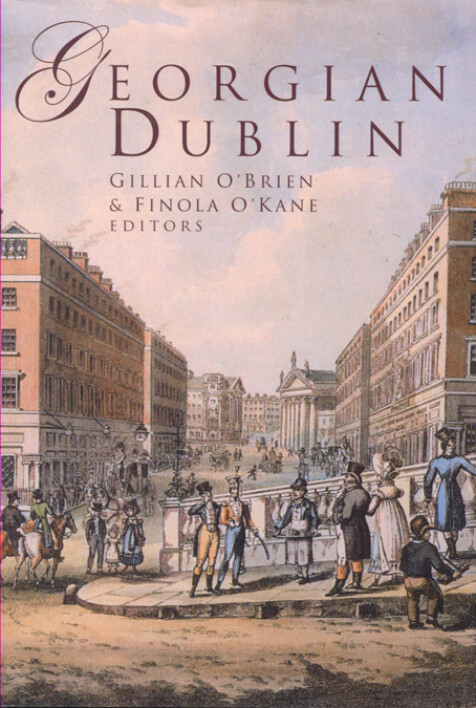Georgian Dublin
Gillian O'Brien & Finola O'Kane editors
‘This excellent new book joins the impressive list of recent publications on Dublin … what makes this book on Georgian Dublin particularly welcome is the fact that it brings together articles by several new and emerging scholars considering areas previously little researched – eighteenth-century Dublin shops, urban volunteering, the use of public space for display and promenade and Georgian suburbia, for instance. It also has one of the strongest and bravest introductions I have seen in a book of this kind. Gillian O’Brien and Fionla O’Kane’s short preliminary essays packs quite a punch … this book is one that brings the reader beyond the built environment of Georgian Dublin to the people who lived in or passed through the city in the eighteenth century ... there is not a weak piece in the book … I strongly recommend that readers give a copy to any developer or planner they happen to pass in the ravaged Dublin suburbs and hinterlands which were, not so long ago, remarkable survivals of the Georgian era. This book will at least alert them to the people who trod those streets and perhaps make them ashamed of what they have destroyed', Andrew Carpenter, Eighteenth-Century Ireland (2009).
‘… through its individual chapters and cumulatively, the book adds valuably to the scholarly literature on the city. It marks a shift away from a Georgian Dublin dominated by jejeune evocations of life in Leinster and Charlemont Houses and around St Stephen’s Green', Toby Barnard, Irish Economic and Social History (2009).
‘This interesting compendium of articles consists of the drawing together of fifteen papers presented first at a conference titled “Bare Bones of a Fanlight: Georgian Dublin” held in May 2006. The topics considered deal with commerce, politics, the professions and the reflection of the eighteenth century city in the arts, most notably literature and painting. It is interesting to note how immediately one experiences the Georgian city from the illustrations … the dust jacket features a detail from Brocas’s “A view from Carlisle Bridge Dublin 1820s”, which makes a most arresting cover with, in particular, a high degree of social detail [while] the black and white reproduction on page 25 gives us a real sense of the Augustan harmony, symmetry and balance of late Georgian Dublin and provides us with a desolating glimpse of what has been lost … Gillian O’Brien and Finola O’Kane properly remind us that the appreciation of Georgian Dublin should go beyond the tourist poster images of the fine classical door cases … The volume provides a very useful perspective on the whole organic structure of this important city towards the end of the eighteenth century. Reading it one is struck by the many continuing human traits that both embellish and disfigure life in our capital. Those were turbulent times and they still are, but we are still lucky even in these days of climate change, pollution and threatened economic collapse to be able to enjoy the magnificent natural location of the city of Dublin, and its surviving eighteenth-century architecture', Senator David Norris, Irish Literary Supplement (Spring 2010).
‘This collection provides an abundance of detail for those interested in the cultural, social and literary history of Georgian Dublin', Andrew Sneddon, Irish Historical Studies (November 2009).
‘It has a varied and colourful content, and bibliophiles will enjoy particularly the representations of Dublin in the fiction of the time in essays by Aileen Douglas and Susan Murphy….’, Noleen Dowling, The Irish Times (December 2008).
‘Provides a significant and interesting into Dublin’s glory days’, Archaeology Ireland (Winter 2008).
‘Georgian Dublin is a new interdisciplinary collection of essays which brings the less obvious and sometimes overlooked elements of the history of our capital city to light ... The mix of disciplines and indeed, styles, make this volume a very enjoyable and accessible read’, Michael Merrigan, Ireland’s Genealogical Gazette (October 2008).
‘Georgian Dublin was a city of paradox. The popular image of elegant squares, grand buildings and fine living conceals a city of poverty, disease and disorder. The contributors to this collection look at both aspects of the city in the 18th and early 19th centuries. Among the topics covered are green spaces and recreation, goldsmiths, cholera and crime. The political aspects of the city in this era are also covered in essays on the Volunteers, the office of the Lord Mayor, the boycott of foreign goods and so on. This collection of essays throws new light on some well known aspects of the city’s past and brings into light the other side of Dublin’, Books Ireland (November 2008).

